
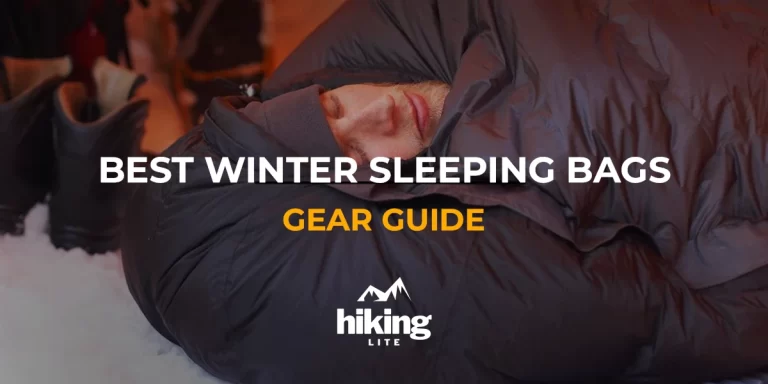
Winter backpacking presents challenges to staying warm in cold conditions. With temperatures dropping at night, a reliable sleeping bag is crucial insulation against the cold.
However, the many options can make choosing one difficult.
When selecting a winter bag, consider factors like withstanding extreme cold without excess weight or bulk. The insulation type and construction quality significantly impact performance. Neglecting temperature rating, fill material, weight, or durability can result in uncomfortable nights.
However, not to worry, we’ve tested this year’s top bags to help you choose the ideal companion for snug, cold-weather nights under the stars.
Let’s get started.
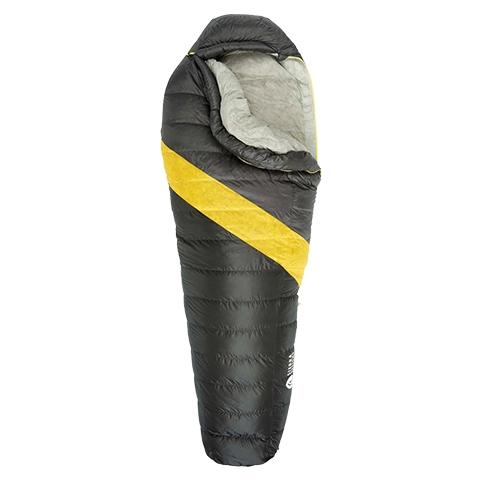
Key Specs
Weight: 2lb 8.2 ounces (1140 grams)
Limit Temp Rating: 0ºF | -17.7ºC
Price: $
PROS
✅ Ultralight
✅ Good for damp nights
CONS
❌ Zipper is a bit tricky
We’ve been testing the Sierra Designs Nitro 0 sleeping bag and have been impressed by its warm and lightweight construction. The hydrophobic 800-fill DriDown insulation retains heat even when our tents get damp inside from condensation.
The mummy shape and Draft Collar work well together to maintain our body heat, while the self-sealing foot vent provides ventilation relief without losing the warmth. The baffle spacing and sidewalls prevent down shift so heat stays consistent wherever we move inside the bag.
We’ve slept comfortably down to slight freezing temperatures using additional insulation from high R-value sleeping pads and base layers. The hydrophobic down also sheds moisture as expected when damp conditions occur in tents.
However, we did find the full length zipper cumbersome to use fully open or closed. While fine stopped around hip level, bringing it up over our shoulders or all the way down proved difficult.
Overall we think the Nitro 0 delivers a warm and comfortable shelter for cold weather camping. But those who appreciate easy in-and-out access through the night may prefer an alternative with smoother zipper operation.
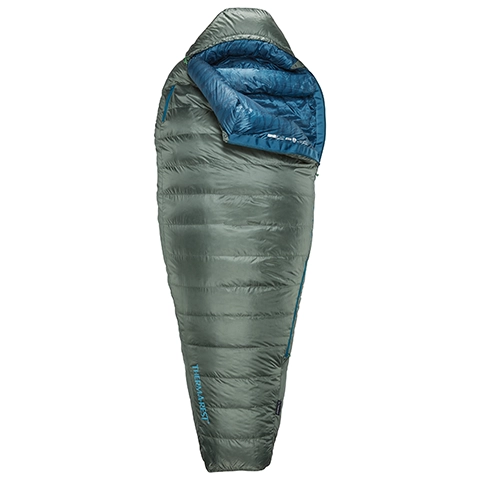
Key Specs
Weight: 2lb 13.5 ounces (1290 grams)
Limit Temp Rating: 0ºF | -17.7ºC
Price: $$
PROS
✅ Hydrophobic down
✅ Small pack size
CONS
❌ Lacking toe box ventilation
The Questar provides practical comfort for frigid conditions through Therm-a-Rest’s proven design. As ultralight backpackers, we appreciate features like the compressible pack size and water-resistant fill.
On a recent snow camping trip where nights dipped just below zero, the Questar kept us warm, dry and toasty. Its roomy “W.A.R.M. Fit” allowed unrestricted side-sleeping and movement without sacrificing efficiency. Mesh walls maximized consistent loft of the 650 fill insulation.
After withstanding non-stop snow and successfully drying wet gear inside, the durable fabrics exceeded our expectations. Morning wake-ups felt refreshingly warm thanks to details like the draft collar and insulated footbox.
While increased ventilation would be welcome on warmer nights, overall comfort and practicality made the Questar a solid companion. Compression and storage sacks optimized our limited pack space.
All told, the Questar delivers incredible value for challenging winter adventures.
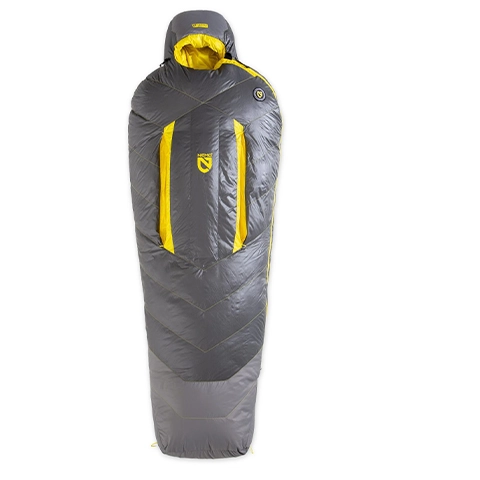
Key Specs
Weight: 3lb 3.8 ounces (1470 grams)
Limit Temp Rating: 0ºF | -17.7ºC
Price: $$$
PROS
✅ -20ºF option available
✅ Great warranty
CONS
❌ Relatively heavy
The Nemo Sonic provides remarkable warmth and adaptability for sub-zero conditions. As backpackers, we appreciate its innovative features that enhance comfort and functionality in extreme weather, including Thermo Gill vents and use of recycled materials.
On recent winter trips where overnight lows reached zero degrees, the Sonic kept us comfortable with its generous insulation and spacious design.
Easy-to-use details like the cinchable hood and knee stretch kept drafts out while allowing freedom of movement. The chevron baffles trapped heat efficiently without cold spots developing.
While not quite as compressible as some competitors, its pack size remains reasonable given the impressive 0°F rating.
We did find that its roomy cut results in slightly less warmth than more form-fitting mummy styles. However, we appreciate the space for unrestricted side sleeping. Smooth fabrics and well-executed zippers complete a bag made for winter adventures.
All told, the Sonic delivers outstanding performance backed by NEMO’s lifetime guarantee.
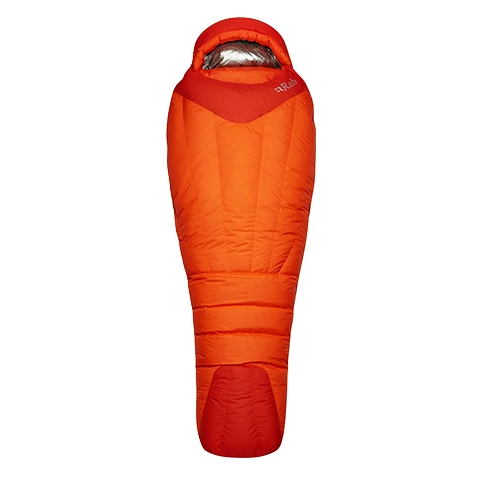
Key Specs
Weight: 2lb 13.5 ounces (1350 grams)
Limit Temp Rating: -2°F | -19°C
Price: $$$
PROS
✅ Extremely warm
✅ Small pack size
CONS
❌ Relatively expensive
The Rab Andes Infinium has exceeded our expectations in challenging sub-zero conditions. Its premium 800-fill goose down, heat-reflective TILT technology and GORE-TEX outer excel at retaining warmth without excess weight or bulk.
During a recent high altitude winter trip with overnight lows well below freezing and heavy frost buildup inside our single-wall tent, the Andes Infinium kept us toasty warm.
Its trapezoid baffles efficiently lofted the down fill for consistent insulation even as condensation deposited and dissipated off the tent walls.
Inside, the extremely comfortable lining material amplified warmth retention. We were impressed by its ability to insulate effectively while perspiring inside from layering down to our base layers. The quality construction feels solidly dependable for enduring extremely cold temperatures.
While its price is certainly higher than many competitors, the Andes Infinium earns it through exceptional performance proven over successive expeditions in harsh mountain conditions.
Overall, this bag meets the demands of serious winter alpinists through dedicated cutting-edge engineering.

Key Specs
Weight: 3lb 2 ounces (1420 grams)
Limit Temp Rating: 0°F | -17.7°C
Price: $
PROS
✅ Good quality
✅ Relatively affordable
CONS
❌ Relatively heavy
❌ Large pack size
We found the Bishop Pass provides decent warmth for winter camping, especially in frigid temperatures near freezing. Its roomier cut compared to standard mummy bags enhanced comfort.
During recent trips where overnight lows dropped into the single digits, the Bishop Pass kept us cozy and insulated. Smart features like the gasketed hood seal and contoured footbox effectively trapped heat.
However, its bulkier packing compromised our ability to bring extra layers and gear for longer ultralight trips. While durable of construction with a rugged zipper, stuffing down smaller proved more difficult than anticipated from a winter bag.
Overall, the Bishop Pass performs well as a budget-friendly option for car camping or shorter backpacking trips when packing light is not as critical. But its pack size presents limitations for more extended winter missions where ounce-counting really matters.
Finding the right sleeping bag for winter camping starts with understanding key specifications that impact performance, weight and price. Let’s break it down:
Evaluating each specification will lead you to a winter sleeping bag retaining warmth while fitting your budget, performance preferences and tolerance for carrying weight into the cold backcountry.
If you’re unsure whether to choose a winter quilt or a sleeping bag, we recommend checking out our detailed post on the matter here.
When selecting a winter sleeping bag, consider the temperature rating to ensure it can handle conditions below 15°F, evaluate the insulation type between down or synthetic based on intended use and weather resistance needs, check the fill weight to find the right balance of warmth and packability, inspect the durable water-resistant shell and soft lining fabrics, look for useful features like draft tubes and cinch cords, determine the ideal shape and size fit for your body and camping style, and factor in extras like compression sacks – weighing these key criteria helps identify a bag tailored for your temperature limits, activity level, and backcountry objectives without overspending on unnecessary bulk or missing critical functionality.
When planning a winter hiking or camping season, outdoor adventurers must choose between down or synthetic insulation for their sleeping bag, with down providing greater warmth-to-weight but risking loss of performance if it gets wet, while synthetics retain insulation even when damp and dry more quickly – so those venturing into colder, wetter, or more extreme winter conditions may prefer a synthetic bag for its reliability in harsher elements, though dedicated ultralight hikers on drier trails could benefit more from down’s improved packability and energy efficiency on longer multi-day adventures in the snow.
Mummy-style sleeping bags are ideal for winter use as their form-fitting tapered shape helps retain body heat by eliminating extra space around the edges that could lead to drafts and heat loss, keeping the warm air trapped closer to the body through an attached hood and draft flap that cinches tightly around the head and neck, along with dual draft tubes running along the full-length zipper to block cold spots, making mummy bags thermally efficient options that maximize warmth for minimal weight on frigid winter expeditions in the mountains or snowy forests.